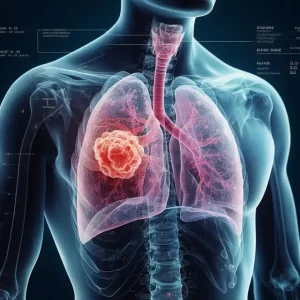COVID-19 may be transmitted back to humans from wild white-tailed deer
- EPA Announces First-Ever Regulation for “Forever Chemicals” in Drinking Water
- Kochi University pioneers outpatient bladder cancer treatment using semiconductor lasers
- ASPEN 2024: Nutritional Therapy Strategies for Cancer and Critically Ill Patients
- Which lung cancer patients can benefit from neoadjuvant immunotherapy?
- Heme Iron Absorption: Why Meat Matters for Women’s Iron Needs
- “Miracle Weight-loss Drug” Semaglutide Is Not Always Effective
COVID-19 may be transmitted back to humans from wild white-tailed deer
- Red Yeast Rice Scare Grips Japan: Over 114 Hospitalized and 5 Deaths
- Long COVID Brain Fog: Blood-Brain Barrier Damage and Persistent Inflammation
- FDA has mandated a top-level black box warning for all marketed CAR-T therapies
- Can people with high blood pressure eat peanuts?
- What is the difference between dopamine and dobutamine?
- How long can the patient live after heart stent surgery?
COVID-19 may be transmitted back to humans from wild white-tailed deer.
40% of the COVID-19 in wild white-tailed deer? The risk of reverse infection after human transmission.
According to a report published in the Proceedings of the National Academy of Sciences (PNAS) on the 23rd of this month, 40% of wild white-tailed deer samples collected in 4 states in the United States after the outbreak of the COVID-19 epidemic in 2021 have antibodies to the COVID-19 virus, showing these white tails Deer has been infected.
This is at least the third study in this month that has achieved similar results in different ways.
It has drawn academics’ concerns that the emergence of a “natural new coronavirus pool” will make divergent evolutionary paths more likely to occur, and ultimately lead to these originals.
It should be an animal that has infected the virus from a human body and transmitted the mutated virus back to humans, adding to the ups and downs of the epidemic in the past two years.
If you remember, as early as the end of last year, there were large-scale new coronavirus infections in mink farms in Europe, and even reverse transmission of the variant virus to humans. In the end, Denmark, Spain, the Netherlands and other countries collectively slaughtered more than 18 million minks, and implemented strict blockade policies near the farms to prevent the spread.
The danger of wild “virus pools”
As mink breeding is very important for fur garments, many companies soon began to develop COVID-19 vaccines for mink.
In October of this year, Finland launched a vaccination of all mink in the country.
If the vaccine is effective, this will not only save the mink fur industry, but also prevent the mink from becoming a virus pool and infecting people in the future.
After all, mink is the only clear record. Examples of the spread of the new coronavirus from people to people.
The problem is that we can use the above-mentioned methods to effectively control the mink in the farm (especially under the premise that these animals will not appear to be anti-closure and anti-vaccine struggle like humans).
However, for the wild Animals, but we do not have the same effective way to prevent white-tailed deer such as the United States from developing into a virus pool, so that the COVID-19 virus will exist in them for a long time, mutate, and eventually even return to humans, causing another wave of epidemics.
According to the statistics of the World Organization for Animal Health (OIE) as of October 31, a total of 598 outbreaks of COVID-19 epidemics in animals have been recorded globally, all over Europe, Asia, the United States, and Africa. many. The victimized animals include cats, dogs, mink, otters, ferrets, lions, tigers, cougars, snow leopards, white-tailed deer, fishing cats, binturongs, South American raccoons, gorillas, etc.
Because these cases are mainly from animals raised by humans, the above-mentioned research on the new coronavirus infection of wild white-tailed deer in the United States has attracted special attention.
They can be regarded as the first studies in the world to assess the prevalence of the COVID-19 epidemic in the wild, and they can only be regarded as the preliminary stage.
There are still a series of questions to be studied in the future: how prevalent is the virus in the deer herd actually? Which strains are the viruses infected by white-tailed deer? Can a deer maintain the virus in the body for a long time like a bat, and will it spread a high amount of the virus?
Regardless of whether the infected white-tailed deer is capable of transmitting the virus back to humans, the results of these studies are indeed worrying.
After all, it is not easy for ordinary people to come into contact with wild deer that can only transmit the COVID-19 virus.
Vivek Kapur, the author of one of the above studies, speculated that if humans leave infected food in the wild and are found by deer, they directly pollute the wild environment (through the discharge of body fluids, etc.), which may cause human-to-human transmission of deer. Ways, especially in hunting activities.
The deer in the study have a relatively high rate of infection, and we cannot rule out that the same situation will occur in other wild mammals. But which animals are likely to be infected by humans and eventually become the new coronavirus pool?
Artificial intelligence predicts “high-risk” species
On the 17th of this month, a paper published in the Royal Society and written by a number of researchers from the Cary Institute of Ecosystem Studies in the United States tried a methodologically innovative way. Provide answers to this question.
Cary’s researchers have noticed the research potential of the fact that the ACE2 receptor is the gateway for the new coronavirus to enter human cells since the beginning of the epidemic last year.
ACE2 is used to regulate blood pressure in the human body and is found in different vertebrates.
This constitutes the possibility of the new coronavirus entering the cells of non-human vertebrates and causing infection.
The researcher’s goal is to know the cross-species infection and transmission capabilities of different species with ACE2 receptors for the new coronavirus, so as to speculate which animals are more likely to become virus pools.
As there are only more than 300 species of ACE2 receptor sequence data, it is not enough to cover the scope of the study.
The researchers first estimated the connection strength between their different ACE2 receptors and the spike protein in the periphery of the new coronavirus by using the known sequence and the model to estimate their cross-species infection and transmission capabilities.
In the course of the research, the research team has successfully predicted the later “successful” cases such as mink, white-tailed deer, cat, dog, and gorilla, and its prediction accuracy for mammals reached about 72%.
The researchers knew that the ACE2 receptor of a species is closely related to its evolutionary history, so they integrated their evolution-related data, and analyzed other ACE2 receptors through a system trained in artificial intelligence machine learning among species with known ACE2 receptor sequences.
The evolution data of species with unknown body sequence finally resulted in the cross-species infection and transmission capacity of more than 5,000 mammals, of which 540 are considered to be likely to become a pool of new coronaviruses, including nearly 200 million in the world.
Buffaloes, cats, dogs, a series of species of monkeys, bats, rodents, etc. that are being traded live.
The researcher specifically mentioned that many “high-risk” rodents, such as many rodents, are the prey targets of cats that are also “high-risk”, which may aggravate the spread of the new coronavirus among these animals. . And “high-risk” animals raised by humans may also escape to the wild and pose a risk of transmission.
The starting point for prevention
Faced with such a large number of “high-risk” species, especially those animals that live close to humans, to prevent them from becoming a pool of new coronaviruses and forming the risk of returning to humans in the future, the most important thing is to prevent humans from spreading new coronaviruses to them.
Industries that have frequent contact with animals (such as veterinarians, zoo management, livestock handlers, etc.) implement strict vaccination and personal protective equipment measures.
Secondly, long-term careful field monitoring and model studies similar to the Kari Institute are needed to find potential virus pools and prevent problems before they occur.
Just like the lessons of SARS in 2003, it is very likely that the new coronavirus from bats is another lesson in how much a virus can threaten humans when it spreads across species.
The identification, monitoring and research of high-risk species can not only help us prevent this pandemic from continuing in another way, it is more likely to prevent the next pandemic from occurring.
The various studies and reports mentioned above are one of the starting points for the academia to stand in the present and look to the future.
COVID-19 may be transmitted back to humans from wild white-tailed deer
(source:internethk01, reference only)
Disclaimer of medicaltrend.org
Important Note: The information provided is for informational purposes only and should not be considered as medical advice.



